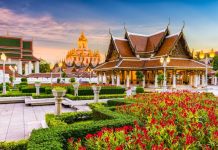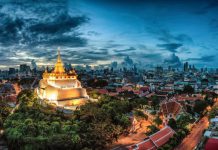
Wat Bowonniwet Vihara, the beautiful monastery of Chakri royalty
Wat Bowonniwet Rajavara Vihara situates on Phra Sumeru Road, Bowonniwet sub-district, Phra Nakorn district is one of the most significant monasteries in Bangkok. Wat Bowonniwet Rajavara Vihara or also called in short locally is “Wat Bowon” is the supreme grade of the first-class royal monastery in which the place is the venue for many Siamese kings and the royalty resided under the protection of the Buddhism. Originally, the temple named “Wat Mai” (means new temple) as on King Rama III invited Prince Mongkut his half younger brother (then he became the King Mongkut) that was in the monkhood and dwelled at Wat Samor Rai (currently is Wat Rachathiwas) to reside at Wat Mai. Prince Mongkut as the abbot of the temple set a precedent of the monks here to followed to the Buddhist disciplines strictly.
Presently, Wat Bowonniwet Rajavara Vihara allows the visitors to sightsee the monastery complex and worship the sacred things inwardly such as ubosot, pagoda, viharas, Phra Tamnak Petr, Phra Tamnak Chandra, the Bell Tower, the Scripture Library, and Phra Tamnak Yai, for instances.
All this, Wat Bowonniwet Rajavara Vihara also is one of two locations to store the ashes of King Bhumibhol (Rama IX). The late king ‘s relic stored at the Buddha Chinnasi’s throne inside the ubosot and allowing the public to worship.
About the Temple
Wat Bowonniwet Rajavara Vihara or also called Wat Bowonniwet Vihara is the highest grade of the first-class royal monastery which founded by Somdet Phra Bawonratchao Maha Sakdiphonlasep, the viceroy in King Rama III.
The temple is former the dwelling of four Supreme Patriarch of Thailand and also the location of Mahamakut Buddhist University which is the first educational institute for monks in Thailand. Also, the place is the insignia temple of King Rama VI (King Vajiravudh) and King Rama IX (King Bhumibhol), as well.
Outstandingly, the monastery is unique from other temples of which it has two main Buddha images (traditionally only one main image for the temple). Those significant sacred statues are Phra Budda Chinnasi that invited from the north chapel at Wat Phra Si Rattana Mahathat Voramaha Vihara in Phitsanulok province in about 1830. And another is “Phra Suwannakhet” or “Phra To” or “Luang Pho Phet”, the huge Buddha image, enshrined behind Phra Buddha Chinnasi, is an initial main image of the ordination hall that Somdet Phra Bawonratchao Maha Sakdiphonlasep invited from Wat Sa Taphan, Petchburi province.
Background of Wat Bowonniwet Vihara
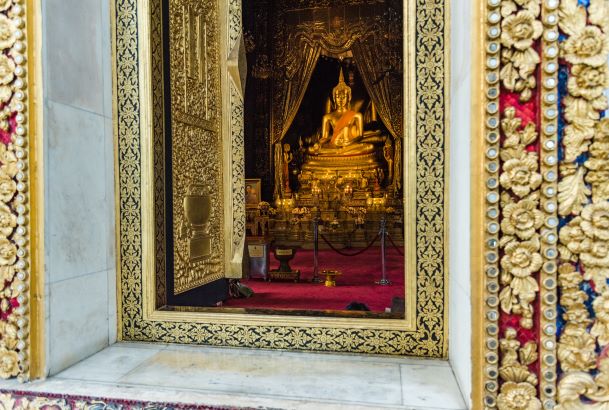
Wat Bowonniwet Vihara is initially a new temple adjoined to Wat Rangsi Sutthawas that later compounded to the same monastery. The monastery was built by the Front Palace in King Nangklao (Rama III) and had nurtured and constructed lots of architectures within the complex. Particularly in late of King Rama III, the king invited Price Mongkut, his half-brother that was in the monkhood to reside at the temple in 1832, resulted in the temple had been restored and developed abidingly.
When Prince Mongkut (while he was in the monkhood as the patriarch) resided at the temple, he initiated the renovation and constructed numbers of permanent structures, included the residence from King Rama III at idem the Front Palace position.
While he was under the protection of the Buddhist umbrella, King Mongkut initiated the religious prescriptions for the Sangha (Buddhist monks) according to the disciples, and lots of monks followed him. The practice was initially called “Bowonnivesathi Order” and later renamed to “Thammayut Nikaya” which means “the group of monks who practice following to the Buddhist disciplines”. That is to say, Wat Bowonniwet Vihara is the first monastery of the Thammayu Nikaya in Thailand.
In the reign of King Vajiravudh, he considered that Wat Rangsi Sutthawas neighbouring Wat Bowonniwet Vihara is very dilapidated. Thence, the king commanded to combine the monastery to Wat Bowonniwet Vihara and called the part “Rangsi Order”. And after the royal cremation of King Vajiravudh, King Rama VII bestowed to invite Rama VI’s ashes to stored under the throne of Phra Buddha Chinnasi inside the ordination hall dated March 25, 1925.
The monastery has been the residence for many kings while they were entering the monkhood which are King Mongkut (Rama IV), King Chulalongkorn (Rama V), King Vajiravudh (Rama VI), King Prajadhipok (Rama VII), and King Bhumibhol (Rama IX), included the significant member of the royalty. Consequently, the royal monastery is regularly maintaining in the excellent appearance. Todays, the temple is plenty of antiques in both religious and art in excellent condition displaying for the visitors to experience and study.
Must-not-miss Pieces of Art at Wat Bowonniwet Vihara
Wat Bowonnevet Vihara is rich in its precious artworks and magnificent architectures for the visitors who have a chance to visit here to see and learn from them. The art within the monastery complex categorised into 2 sections which are the Buddhawas section and the Sanghawas section. Those are divided by the wall and ditch connected with the walking bridge. And here are the majoring artworks of the temple that you should not miss.
The art in Buddhawas Section
The architectures and pieces of skill in the Buddhawas (section contains the ordination hall, chapel, cloister gallery, etc.) are
1. Ubosot of Wat Bowonniwet Vihara

Ubosot was built at the time of establishment of the temple in the reign of King Rama III with multiple times of renovation. The ordination hall is the traditional design that was famous in the age. The front portico sticks out from the primary structure, squared pillars and verandah rounded the door and window panels. The pediment decorated with the fresco. In the reign of King Mongkut, the ubosot was restored by roofing with corrugated porcelain and the pediment ornamented with coloured-ceramics, also the king ordered Khrua In Khong who is one of the most celebrated artisans of Siam create the mural painting interior the ordination hall. While the exterior wall was repaired with the marble decoration.
The columns at the front are the square shape with western style frieze, and the door and window panels ornamented with gild and stained glass. The Sema – the boundary marker of the temple at the front is old craftsmanship in Uthong pattern made from the red sandstone from Wat Wang Gao in Petchburi province. While the others are unique by attaching on the wall instead of setting them on the ground surrounding the ubosot.
The rear of the ordination hall is the pagoda from the Rama IV’s period, and then it covered with the gold tiles. Notably, the architecture of art of the ubosot at Wat Bowonniwet Vihara is outstanding unique caused by a blending of traditional art in Rama III’s age that tends to Chinese style and King Rama IV which influenced by the western art. However, the ordination hall in overall based on the Thai art which is another exotic and beautiful architecture, indeed.
2. Mural Painting inside the Ubosot

Apart from the Buddha image, the mural painting that King Mongkut initial ordered Krua In Khong created is the delicate and exquisite art. The picture is the outcome of the point of time of the influence of the western mixed to Thai traditional art. It assumed that the painting was created since the Prince Mongkut relocated to the temple.
The mural painting and decoration are the story of Buddha that is right on the wall beyond the door and windows. 16 chapters are beginning at the rear wall on the left side (west) counted as number 1 and move clockwise passes the central Buddha in the ubosot orderly. Also, the inscription embedded in the doorways and windows in total 16 panels. Besides, there is the painting about the puzzle of the Buddhist precepts regarding Chala Picharti – the heart of 6 types of human.
3. The Buddha images
Phra Suwannakhet or Lung Pho To

Within the ordination hall contains two important Buddha images which are the main sacred images. One is a massive molded Buddha “Phra Suwannakhet” or “Lung Pho To” with approximately 5 meters of lap size. The statue brought in pieces from Wat Sa Taphan in Petchburi by the viceroy in Rama III who built the monastery and reassembled. It assumed that the figure originally was Dvaravati with a large knot; however Phraya Chumni Hattakarn, the artisan of the Front Palace took it off and replaced to the smaller one which made from baked clay and lacquered and gilded. A meter lap size images of a couple of the chief disciples sitting at the front of the main image.
Phra Buddha Chinnasi
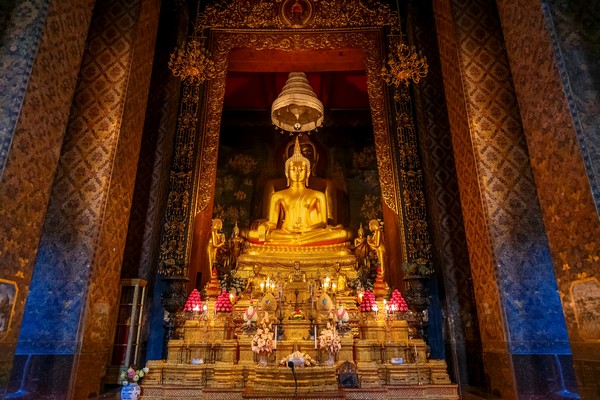
Another important Buddha statue is “Phra Buddha Chinnasi” respectful invited from Wat Phra Si Rattana Mahathat in Phitsanulok province in the rainy season in 1830. Later in the year after, the Buddha was covered by gold leaves, coated the radios, replace the eyes, and removed the Unna (the Buddha’s eye). The statue was cast at the same time of the most beautiful Buddha image in Thailand “Phra Buddha Chinnarat” (currently enshrines at Wat Phra Si Rattana Mahathat, Phitsanulok) and it considered that Phra Buddha Chinnasi is another most magnificent Buddha image.
Phra Buddha Narawantabophit
Additionally, during the ordination period of King Bhumibhol that he resided at Wat Bowonniwet Vihara. The king ordered the artisans of the Department of Fine Arts to create the Buddha image in the attitude of stopping the rainstorm, and the king presided over the ceremony to making the mould on December 5, 1956. And the Buddha image named by Somdet Phra Sangharaja Chao Kromma Luang Vajirananavongs, the 13th Supreme Patriarch of the Rattanakosin is “Phra Buddha Narawantabophit”.
Anyhow, there are a lot more of the Buddha images which are all the magnificent artworks enshrined at Wat Bowonniwet. So, if you have a chance to visit the monastery, it is worthwhile for you to take the time to witness the beauty of them.
4. The Pagoda
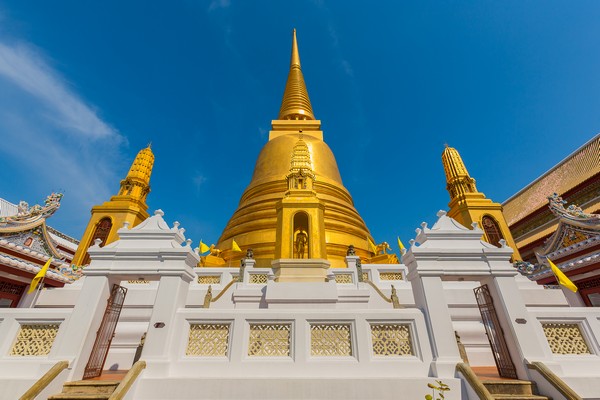
Next to the ubosot is the Pagoda which is rounded in shape. The enormous chedi was built in the reign of King Rama IV covered with the gold colour tile. Presently, the chedi’s base surrounded by the Chinese pavilion and further from the backward is the Chinese Vihara of where the beautiful mural painting of the Chinese craftsman.
The main chedi coated with gild is the house to enshrine the Buddha’ relic, and there are more four satellite pagodas rounded the primary structure. Any Buddhist or the visitor who would like to worship can do it at the shrine of the copying model of “Phra Pairee Pinat” at the front of the chedi.
5. Vihara Phra Sassada
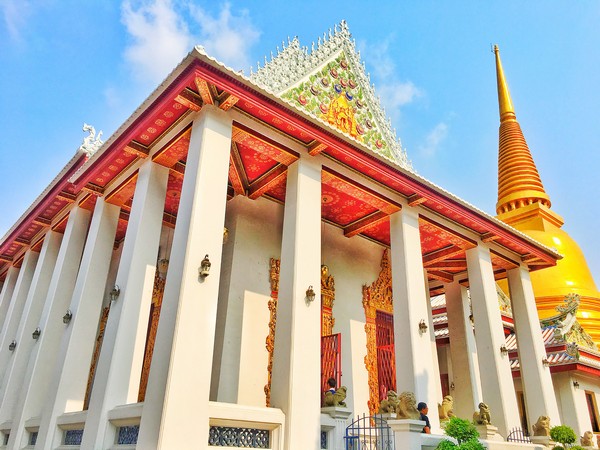
It is a large chapel divided into 2 partitions. The interior of the building is glorious with the mural painting of the story of Buddha and the Jatakas which created in King Rama V’s age and is assumed to be the work by Krua In Khong. Inside the hall at the front housed “Phra Sassada” the Sukhothai bronze Buddha statue in the attitude of subduing Mara that King Mongkut bestowed to relocated from Wat Suthat. And the back is the place to enshrine a declining Buddha “Phra Buddha Siya” – bronze, lacquered, and gilded image from Sukhothai era. Also, the ashes of Somdet Phra Maha Samana Chao Kromma Phraya Vajirananavarorasa, the 10th Supreme Patriarch of Rattanakosin Kingdom stored at the altar of the image, as well.
5. The Copy of the Buddha’s Footprint

Another interesting sacred object within the Buddhawas is the Copy of the Buddha’s Footprint or “Phra Buddha Bata”. The holy thing is the antique from Sukhothai era enshrined next to the pavilion near the ubosot.
6. The Royal Pavilion to Uncloak
The building that specialty built at the important royal monasteries to be the place for the king to uncloak and bathe before get in the ordination hall for the religious activities.
7. Vihara Keng (the Chinese Roof Chapel)
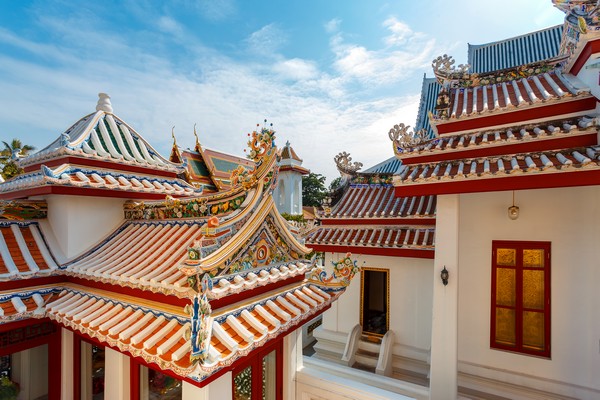
It is an architecture built in the reign of King Mongkut, the Rama IV of Siam, nonetheless it had not completed. Later, King Chulalongkorn continued the construction and renovation until it finished, further the king bestowed to furnish the Vihara with the Chinese pattern included the mural painting of “The Three Kingdoms” epic. Interior houses three important Buddha statues which are the symbolic Buddha of the former abbots of the monastery namely;
7.1 Phra Buddha Vajirayan
“Phra Buddha Vajirayan” is a high attired Buddha image in the attitude of stopping the rainstorm enshrined at the centre of the chapel and faces to the south. The image was cast by King Rama V to honour his father, King Mongkut who was the first abbot of Wat Bowonniwet Vihara in 1885. The name of the Buddha came from the title of King Mongkut when he was in the monkhood as “Vajiranono”.
7.2 Phra Buddha Panya Akkha
“Phra Buddha Panya Akkha” is an insignia Buddha image of Somdet Phra Maha Samana Chao Kromma Phraya Pavares Variyalongkorn, the 2nd abbot of the royal monastery. The statue that cast at the same time of Phra Buddha Vajirayan housed in the east. It is a Buddha image in the attitude of stopping the rainstorm with the robe placing upon both shoulders and supplementary of 5-tier umbrella. Below the important Buddha image stored the ashes of the abbot.
7.3 Phra Buddha Manussanak
And “Phra Buddha Manussanak” which is a standing Buddha image with the robe placing upon both shoulders enshrined in the west. The image is the symbolic Buddha image of the 3rd abbot of the temple – Somdet Phra Maha Samana Chao Kromma Phraya Vajirananavarorasa that King Prajadhipok bestowed to enshrine at the chapel in 1930.
7.4 Phra Buddha Patima Tikayu Mahamangala
Additionally, there is another Buddha image that was enshrined at the chapel later which is “Phra Buddha Patima Tikayu Mahamangala”. The Buddha enshrined at the east of the vihara renowned among the local Buddhists in the name “Luang Pho Dum” (the venerable Black Buddha). The image was created in the occasion of Somdet Phra
Sangharaja Chao Kromma Luang Vajirananavongs’s 80th anniversary, also his relic is stored at the sacred statue, as well. So that is the fourth insignia Buddha image of the abbot of Wat Bowonniwet Vihara.
Anyhow, for one who would like to pay homage to the ashes of the late Supreme Patriarch -Somdet Phra
Nyanasamvara that stored under the pedestal of the copying “Phra Buddha Chinnasi” located inward the area of this vihara. The imitating Phra Buddha Chinnasi was cast when the Supreme Patriarch was 84 years.
The Art inside the Saghawas section
Sanghawas is the section including the dwelling of monks and novices. The art within this section of the temple most created in Rama III and Rama IV to be the residence of the king when entering the monkhood.
1. Phra Tamnak Panya (the Hip Roof Royal Residence)
The residence was built by King Rama III to bestowed to the Prince Mongkut. It is 3-stories European architecture and was the dwelling for King Mongkut all through his monkhood at Wat Bowonniwet Vihara. Later, the residence has been resided by the kings, and the royalty who ordained to the monkhood at the monastery included King Bhumibhol the Rama IX. And he graciously planted a teakwood at the back of Phra Tamnak Panya on the day he disrobed.
2. Phra Tamnak Lang (the Lower Royal Residence)
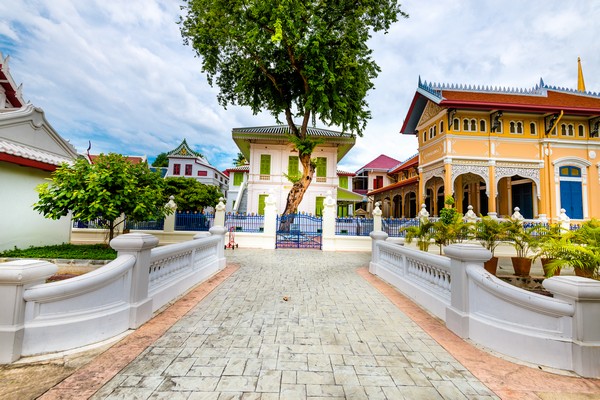
Next to the Tamnuk Panya was Built by HM King Chulalongkorn with the asset of his daughter Princess Chandra Saradavara to be the residence of Somdet Phra Maha Samana Chao Kromma Phraya Vajirananavarorasa. And then the building was used as the venue of Mahamakut Buddhist University when it established. Currently, it is the office of Thummayut Sect.
Within the area of Phra Tamnak Lang in the east adjacent, the fence is a small pavilion with 2 sides porches. The structure was the royal pavilion of Queen Sri Suriyendra in HM King Phutthaloetla Naphalai, and King Mongkut commanded to relocated to the temple in 1909.
3. Phra Tamnak Petr
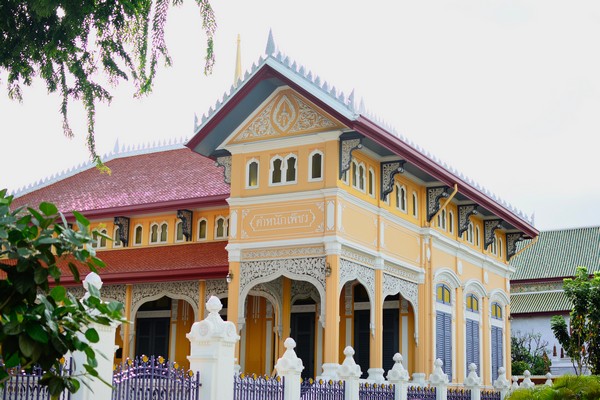
Phra Tamnak Petr or the Diamond Hall is on the right from the front entrance. It is 2-level building in western style and the front porch furnished with the delicate fretwork. The residence was built by HM King Vajiravudh to be the hall for Somdet Phra Maha Samana Chao Kromma Phraya Vajirananavarorasa.
4. Hor Saha Chorn
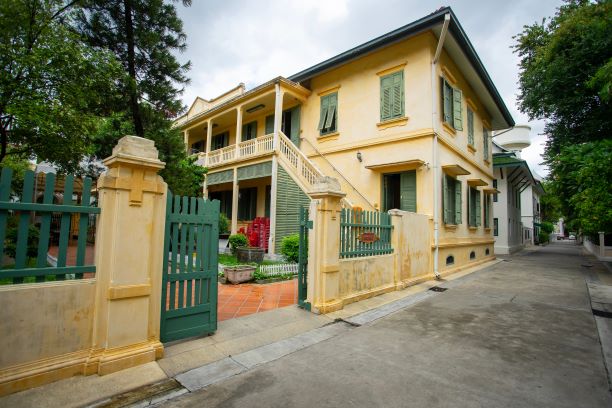
The building is the early Rattanakosin design which influenced by Europe. It was restored and adapted by HM King Prajadhipok to dedicate to the King Mongkut and Somdet Phra Maha Samana Chao Kromma Phraya Vajirananavarorasa his preceptor.
5. Phra Tamnak Sai (the Left Royal Residence)
The residence was constructed in the reign of King Rama V in the Rattanakosin style. The long-shaped architecture with jutting out portico and decorated with the beautiful and aesthetic fretwork. The building was used by Somdet Phra Maha Samana Chao Kromma Phraya Vajirananavarorasa as the working place.
6. Hor Phra Tripitaka (The Scripture Hall)
Inner the Scripture Hall is the biggest gold appliqué on black lacquer Tripitaka bookcase in Thailand. The hall is magnificent with the exquisite mural painting of the Buddhist story, predictably it made in the period that King Mongkut was the abbot.
7. Mahamakut Buddhist University
The place Buddhist learning centre for monks and novices that developed to be Mahamakut Buddhist University, the first Buddhist university in Thailand. The place originated the Buddhist learning curriculum or so-called in short “Nak Dhamma” (the Buddhist Student) which is the fundamental course for Sangha or Buddhist monks in Thailand. The institute found on October 1, 1893, with the royal permission of HM King Chulalongkorn according to the initiated idea of Somdet Phra Maha Samana Chao Kromma Phraya Vajirananavarorasa to be the post-academic institute for the Buddhist monks.
Afterwards, Somdet Phra Sangharaja Chao Kromma Luang Vajirananavongs organised the academic council of Mahamakut Buddhist University dated on December 30, 1945. And later the Sangha Supreme Council of Thailand granted the institute to be free of charge Buddhist University in Thailand on May 16, 1974.
How to go to Wat Bowonniwet Vihara
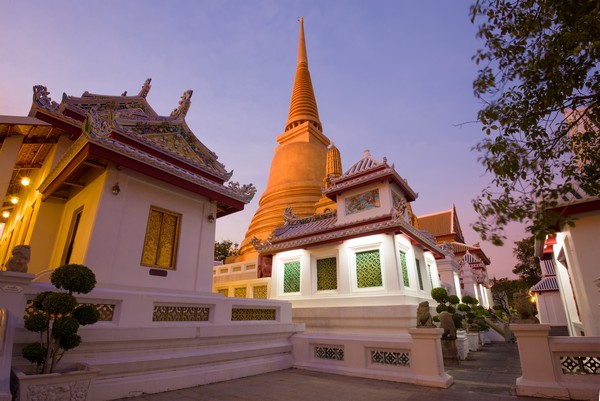
The royal monastery allows the visitors to enter daily between 9.00am-5.00pm; however there are some parts of the complex with limited access. And the tourists should get the proper dress by avoiding any short pants & skirt, armless top.
And to travel to the temple is convenient by BTS by getting on the BTS (Silom Line) and gets off at Taksin Bridge Station at Exit 2. Then, you transit to the boat service at Chao Phraya Express Boat Pier to Phra Athit Pier. And you continue the journey by taxi or Took Took to the temple that situates nearby Bang Lamphu Market where you can find lots of delicious local street food, as well.

